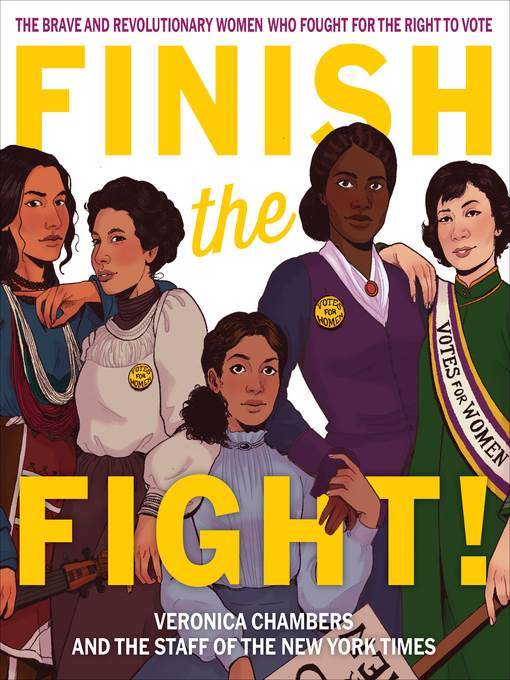
Finish the Fight!
The Brave and Revolutionary Women Who Fought for the Right to Vote
فرمت کتاب
ebook
تاریخ انتشار
2020
Reading Level
7
ATOS
8.1
Interest Level
4-8(MG)
نویسنده
The Staff of The New York Timesناشر
HMH Booksشابک
9780358407829
کتاب های مرتبط
- اطلاعات
- نقد و بررسی
- دیدگاه کاربران
نقد و بررسی

Starred review from June 1, 2020
Grades 5-8 *Starred Review* This informative book takes a refreshingly inclusive approach to the history of women's voting rights in the United States. In addition to recognizing the contributions of well-known figures such as Susan B. Anthony and Elizabeth Cady Stanton, it widens the spotlight, profiling leaders who have represented minorities and describing the particular challenges they have faced as they worked to promote women's suffrage. Representing generations of voting-rights activists within the American Indian, Black, Chinese American, Latina, and LGBTQ+ communities, the featured leaders include Mary Church Terrell, Angelina Weld Grimk�, Mary Burrill, Mabel Ping-Hua Lee, Ida B. Wells-Barnett, Jovita Id�r, Susette La Flesche Tibbles, and Zitk�la-?�. The text, written with clarity and verve, also acknowledges racist attitudes within the mainstream women's suffrage organizations of the nineteenth and twentieth centuries, while showing how the voting-rights movement was intertwined with other important causes, such as abolition, temperance, and the struggle of Native Americans to protect their lands and traditions. The book has a fresh, inviting look. Illustrations include vibrant, distinctive, full-page digital portraits as well as period photos and documents brightened with colorful elements. An appended section features 46 Brave and Revolutionary Women You Should Know and displays their images on trading cards along with fast facts. A valuable resource for library collections.Women in Focus: The 19th in 2020(Reprinted with permission of Booklist, copyright 2020, American Library Association.)

July 1, 2020
Gr 4-8-The New York Times staff collaborated to commemorate the 100th anniversary of the ratification of the 19th Amendment and provide a feminist look at prominent leaders of the women's suffrage movement. While readers may recognize names like Susan B. Anthony, this critical text successfully reframes the movement, centering queer women, women of color, and Native women whose stories have been excluded. Chapters about Ida B. Wells-Barnett, Mabel Ping-Hua Lee, and other trailblazers expose racism within the movement and examine the relationship between women's suffrage and civil rights. Stunning, full-page portraits mark each chapter, though some include confusing elements such as a bird perched on the shoulder of Dakota Sioux activist Zitk�la-S� without the context that her name translates to "red bird." VERDICT This collection of remarkable women will make for a thorough primary source for middle grade research projects. The book's social justice lens is an obvious strength. Recommended for school and public libraries, especially where whitewashed histories detailing the suffrage movement need updating.-Allison Staley, Lake Oswego P.L., OR
Copyright 2020 School Library Journal, LLC Used with permission.

July 1, 2020
An illustrated introduction to many women of color and queer women responsible for voting rights in America. Beginning with the Haudenosaunee Confederacy, whose historic territory was the site of the Seneca Falls convention, and ending with Dakota Sioux activist Zitkála-Šá, this friendly primer highlights the lesser-known heroes whose fight for their right to vote did not end with the ratification of the 19th Amendment. Chambers and her co-authors from the New York Times strike an authoritative yet colloquial tone: "[T]here are tons of women beyond Susan [B. Anthony] and Elizabeth [Cady Stanton]'s demographic who helped make suffrage a reality for all women," they write. Well-chosen quotes and engaging biographical information about such activists as Frances Ellen Watkins Harper, Mary McLeod Bethune, Angelina Weld Grimké, Mabel Ping-hua Lee, and Jovita Idár are interspersed with trenchant observations from contemporary women working in service to their ancestors' ideals, including Louise Herne, Charlotte Brooks, and Vilma Martínez. White and straight women are supporting characters, either as allies or barriers. Ornate, colorful page layouts also include playful doodles, at times somewhat distractingly atop historial images. Stories like that of Susette La Flesche Tibbles, who had to stand up to several white government officials before she could become the first Native woman to teach on her reservation, emphasize the theme that rights require constant advocacy. Timely, moving, and necessary. (authors' note, minibiographies, timeline, statistics, acknowledgements, further reading, bibliography, index) (Collective biography. 8-14)
COPYRIGHT(2020) Kirkus Reviews, ALL RIGHTS RESERVED.

Starred review from November 9, 2020
Declaring “suffrage history needs a makeover,” Chambers and other staff writers at the New York Times mark the centenary of the 19th Amendment’s ratification with this refreshing compilation featuring some of the American suffrage movement’s unsung heroines. Thirteen chapters highlight these lesser-known champions, who were often part of other rights struggles. African American, Native American, Asian American, Latinx, and queer suffragists occupy pages illustrated by various artists in the hues of the movement: purple, blue, and gold. Striking full-page color portraits and simple floral motifs accompany archival photographs of suffragists such as newspaper founder Josephine St. Pierre Ruffin and journalist Jovita Idár. Straightforward reportage reveals the movement’s complexity, with attention paid to internal discrimination, as well as to inspiration derived from matriarchal Native American societies. Sidebars add context, one cleverly depicting the state ratification process through a game board. A timeline, bibliography, and index conclude, along with eye-catching spreads of colorful trading cards featuring many more voting rights pioneers. A “Women by the Numbers” spread compares statistics from 1920 to 2020. A welcome, more inclusive panorama of suffrage history. Ages 8–12.

























دیدگاه کاربران